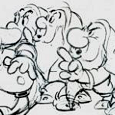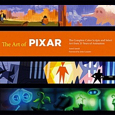![Mark Smith [Click to view larger-sized version of image]](http://animatedviews.com/wp-content/uploads/2007/07/marksmith-sm.jpg) Mark Smith, the owner and operator of MarkToons Video Animation, recently took the time to share some thoughts regarding his latest book, The Art of Flash Animation: Creative Cartooning, with Animated News & Views’ Josh Armstrong. The publication examines how one may best apply the popular software, while also discussing other rules and tips that may help those working, and wanting to work, in the animation industry.
Mark Smith, the owner and operator of MarkToons Video Animation, recently took the time to share some thoughts regarding his latest book, The Art of Flash Animation: Creative Cartooning, with Animated News & Views’ Josh Armstrong. The publication examines how one may best apply the popular software, while also discussing other rules and tips that may help those working, and wanting to work, in the animation industry.
In addition, Smith reminisces on his career thus far, recalling when he first knew he wanted to be an animator. Having been a student in the Animation MasterClass of Richard Williams, Smith later became a teacher himself, instructing for Auburn University Montgomery. In the meantime, Smith has experienced a wide variety of creative endeavors, from animation and illustration to puppetry and literature. A generous sample of his work, as well as detailed explanations of his services, may be viewed at MarkToonery.com.
Animated Views: How did you become involved with animation?
Mark Smith: Well, as I say in my book The Art of Flash Animation, I guess as a kid I always loved animation. I remember watching Saturday morning cartoons and getting all excited when those animated specials would come on CBS with that cool 1970s computer graphics logo spinning out: ‘CBS Special Presentation!’ Mainly, I remember the Peanuts Halloween special and this other 1981 special from Lee Mishkin that you can’t get on DVD (yet) called Faeries (not to be confused with the confusing title by the same name with Kate Winslet and Jeremy Irons), based on Brian Froud’s illustrations from the book of the same name. And naturally, the Disney features like Rescuers and Robin Hood came out when I was young.
But then something happened in my teenage years. I decided I wanted to be a writer and developed a typical snotty teenage attitude. One time I showed my Sunday school teacher some of my stories, and she suggested I try writing for animation. Then I made my infamous quote, ‘Animation? Animation is for children.’ Now I kind of wonder what made me say that; I’d loved animation as a kid, and even at that time, I was probably still doing puppet shows, because I was always a huge Muppet fan. And you could argue the point, but most would probably say nowadays that puppets have more of a widespread reputation of being for children than animation.
 Anyway, two years after that, some friends and I went on what we thought would be our last blast before graduation and ended up going to see The Seventh Sign. They had a built-in preview of Who Framed Roger Rabbit, which looked like an actual cartoon short subject before it went to the live-action movie set. I had just never seen animation move like that before. I thought it was even better animated than the cartoons it was ‘parodying.’
Anyway, two years after that, some friends and I went on what we thought would be our last blast before graduation and ended up going to see The Seventh Sign. They had a built-in preview of Who Framed Roger Rabbit, which looked like an actual cartoon short subject before it went to the live-action movie set. I had just never seen animation move like that before. I thought it was even better animated than the cartoons it was ‘parodying.’
At that point, I think, is when I just looked up at the screen and thought to myself, ‘Animation! That’s what I want to do for a living.’ I had already been enrolled as a Theatre major at Montevallo, so at my first opportunity, I switched over to an art major – I had always been drawing, illustrating my own stories. And then my family announced they couldn’t afford to keep me at Montevallo.
I was living at my childhood home, and they were in Montgomery, an hour away. One of my brother’s co-workers – he was working at a movie theatre – said they had an animation class at Auburn University Montgomery, so I didn’t put up a fight at having to move back in with the family. I enrolled at AUM and convinced the Dean at the Art Department that I could take the Video Animation class without the prerequisite.
AV: When and why did you decide to start MarkToons Video Animation?
 MS: I started MarkToons, I guess as far back as 1992. That was the first invoice I found, when I did some animated intros for WCOV-TV, Montgomery’s Fox affiliate. I created Farley Fox for them, a little animated emcee who would introduce their syndicated package of cartoons, like Tiny Toons, Darkwing Duck and Goof Troop.
MS: I started MarkToons, I guess as far back as 1992. That was the first invoice I found, when I did some animated intros for WCOV-TV, Montgomery’s Fox affiliate. I created Farley Fox for them, a little animated emcee who would introduce their syndicated package of cartoons, like Tiny Toons, Darkwing Duck and Goof Troop.
For instance, Farley would look offscreen and yell ‘Duck!’ A generic cartoon duck would fly, quacking over his head, and Farley would say, ”Cuz Darkwing Duck is coming at ya, next on WCOV-TV!’
Naturally, I provided Farley’s voice as well. I do most of my own voiceovers. My first weekly paycheck was as a DJ at Chilton County’s only radio station, an AM-FM station called WEZZ/WKLF. And of course I had done the puppet shows, so all those weird voices were now somewhat profitable.
But you asked why? Because something appeals to me about being able to sit at home and draw cartoons for a living.
AV: Getting started must have been both exciting and nerve-wracking. What was it like in those early days of creating your company?
MS: I bought a business license, I think for about $30 or so. And I did an invoice, probably in PageMaker, on the Macs at school.
 My Video Animation instructor, a guy named Marc Holcombe, had suggested I consider getting an Amiga Computer, because at that point, they were the ‘third contender,’ after Macs and PCs. There was a pretty good issue of AmigaWorld at the time, an Animation special, with a blonde ripoff of Jessica Rabbit on the cover. As much as I loved Roger Rabbit at the time, I thought it was a sign, so I bought an Amiga 2000 with the money we had left over from selling this convenience store my family had in Chilton County. I then bought a digitizing tablet and a basic animation program called MovieSetter that was a really low-res version by today’s standards, but it had sound effects capabilities. I used that with a genlock (you needed one in those days to transfer computer signals to video), and I was able to overlay my animated characters over live camcorder video of backgrounds I’d drawn in art markers.
My Video Animation instructor, a guy named Marc Holcombe, had suggested I consider getting an Amiga Computer, because at that point, they were the ‘third contender,’ after Macs and PCs. There was a pretty good issue of AmigaWorld at the time, an Animation special, with a blonde ripoff of Jessica Rabbit on the cover. As much as I loved Roger Rabbit at the time, I thought it was a sign, so I bought an Amiga 2000 with the money we had left over from selling this convenience store my family had in Chilton County. I then bought a digitizing tablet and a basic animation program called MovieSetter that was a really low-res version by today’s standards, but it had sound effects capabilities. I used that with a genlock (you needed one in those days to transfer computer signals to video), and I was able to overlay my animated characters over live camcorder video of backgrounds I’d drawn in art markers.
The first time I guess I really ‘broke out’ in getting more steady freelance work was when I made a flier for an ‘Animation Sale,’ maybe in ’95, right around the time I moved out of my parents’ house. I took it to all the local TV stations, and I got a call back from the cable company.. they’ve changed names so many times since then I honestly couldn’t tell you what they were at that time. One of their salespeople said a client of his, Quik Pawn Shops, thought an animated commercial was a pretty cool idea. I think I might have gotten $1,500 for it. I ended up doing roughly half a dozen commercials for them; again, I really couldn’t say how many. I did the first one on a ‘title loan’ deal, with a guy picking up his car and carrying it inside. The next one I remember doing was a jewelry fashion show, which I did three versions of: one with jewelry, one with musical instruments… and another version that escapes me. I’m pretty sure the last one I did was the Christmas ad, which is undoubtedly my favorite, with the three little pigs – my wife did the backgrounds for me on that one. It’s still on my demo reel.
AV: What are some of the most memorable jobs your company has been asked to do?
 MS: Okay, that’s a tough one. I guess one of my favorite jobs has been one of the rare occasions when I had a decent budget to produce a five-minute cartoon, for Thermalex. What I mean by a ‘decent budget,’ was that it impressed me at the time. It was enough to hire about half a dozen students from the Animation Class I was teaching – I had started teaching that at Auburn University Montgomery in 1995 – as assistants. It was a lot of fun. I didn’t have an office; everybody just came over to my apartment. I was animating, my brother and one of our friends, Shawn – both students – were inbetweening, inking, scanning and digitally painting the cels in MacroMedia Director. (I essentially gave up on the Amiga in ’95, and had bought a PowerMac.)
MS: Okay, that’s a tough one. I guess one of my favorite jobs has been one of the rare occasions when I had a decent budget to produce a five-minute cartoon, for Thermalex. What I mean by a ‘decent budget,’ was that it impressed me at the time. It was enough to hire about half a dozen students from the Animation Class I was teaching – I had started teaching that at Auburn University Montgomery in 1995 – as assistants. It was a lot of fun. I didn’t have an office; everybody just came over to my apartment. I was animating, my brother and one of our friends, Shawn – both students – were inbetweening, inking, scanning and digitally painting the cels in MacroMedia Director. (I essentially gave up on the Amiga in ’95, and had bought a PowerMac.)
But just the whole atmosphere, of working with this fun bunch of student artists, was what I remember fondly. Everybody scrambling around my little two-bedroom apartment to meet this deadline for a Sales Video, for some trade show… My sister-in-law did the female voice, Shawn did the husband, my brother did the kid, and I did the voice of this dragon/dinosaur, as well as this know-it-all doctor. Ahh… good times, good times. But today, I wouldn’t be able to afford assistants on a budget like that. I’d just knuckle down and do everything myself, which is mostly how I work now.
AV: What are some humorous experiences you’ve had with clients?
 MS: Well, I wouldn’t have made a sarcastic comment to a new client like this, but I knew the guy, Brad, the Marketing Director at Quik Pawn, by now. He said to me after we’d finished discussing the budget for their latest spot, ‘Well, Mark, what kind of animation could you do for me at $35?’
MS: Well, I wouldn’t have made a sarcastic comment to a new client like this, but I knew the guy, Brad, the Marketing Director at Quik Pawn, by now. He said to me after we’d finished discussing the budget for their latest spot, ‘Well, Mark, what kind of animation could you do for me at $35?’
‘For $35, I’ll draw the character in purple crayon on a raggedy, torn-out yellow sheet of legal pad paper, and wiggle it back and forth in front of a camcorder.’
The other had to be ‘Gladys.’ I’d just done a film of this octopus for her (still my longest film to date), and she was… well, a sweet lady, to be fair, but a bit of an ego trip. After we had spent nearly nine months on this 13-minute animated short film, we showed her the final print – at least we hoped it was about to be the final. So she sat there a minute afterward, and said to me, as serious as could be, ‘You know, I saw this film on television last night about bats. And I am really liking the bats. Is there some way we could put a bat somewhere in this film?’
‘Well,’ I said, thinking as quickly how to be diplomatic and defuse this ludicrous suggestion before it went any further, ‘this octopus film takes place underwater, and the first thing someone watching this film for the first time would say to themselves would be… ”Hey, what’s a bat doing in the ocean?!”
Thankfully, she saw reason, and I have to give her credit for that.
AV: Could you please elaborate on your time with Richard Williams?
 MS: It was all too short. It was only three days. He said, ‘What’s taken me thirty years to learn I’m ramming out in three days.’ People who hear me talk about it probably think I spent a week or more at his Animation MasterClass in San Francisco, back in June of 1997.
MS: It was all too short. It was only three days. He said, ‘What’s taken me thirty years to learn I’m ramming out in three days.’ People who hear me talk about it probably think I spent a week or more at his Animation MasterClass in San Francisco, back in June of 1997.
There were about three hundred people in the class, and I met some great artists. I met these guys working on Space Jam, like Don Smith and Frank Gabriel. Somebody there gave me a VHS work-print of Thief and the Cobbler, Dick’s legendary unfinished classic. Sadly, the only copy commercially available is a hacked-to-pieces remnant of what it was meant to be.
I also met a lady from Pixar who had worked on Toy Story. I ‘re-met’ Clay Croker, who did Zorak and Moltar (animated and voiced-over) for Space Ghost: Coast to Coast. I was delighted that he remembered me from our first meeting in Atlanta’s Dragon-Con.
As for Dick Williams himself, I did my usual ‘how to meet famous people’ trick. I saw no one else had the guts to approach him yet, during one of the first class breaks, so calmly walked forward, hoping I didn’t get side-tackled by a bodyguard or security (thankfully, neither were present), and I walked over to talk to him. I introduced myself and told him how I’d looked up at the screen during Roger‘s preview and said, ‘That’s what I wanna do for a living!’ He just sort of blinked and said, ‘Oh, thank you! Thank you very much!’
I asked him to autograph my copy of Animation Magazine, with him holding the Roger Rabbit portrait on the cover. His wife, Mo Sutton, a lovely person with a charming British accent, said, ‘Oh Dick, your brother took that photo, didn’t he?’
I was fairly new to animation at the time (by comparison with the other 299 people in the room), so I thought, ‘Well, I got my degree in Graphic Design. I’ll ask him a design question, then.’ So I raised my hand during class one afternoon and asked, ‘What’s your favorite character from a design standpoint?’
He replied, ‘The Thief. Because his design is so simple.’
 The other thing I remember about the Richard Williams class was what a great performer this guy is. An animator is supposedly an actor with a pencil, and Dick is both. The problem was I would get wrapped up in these great anecdotes he was telling, and think to myself, ‘Wow! I’m listening to Richard Williams, the Animation Maestro himself! He animated Roger Rabbit, that great movie that got me interested in animation in the first place!’
The other thing I remember about the Richard Williams class was what a great performer this guy is. An animator is supposedly an actor with a pencil, and Dick is both. The problem was I would get wrapped up in these great anecdotes he was telling, and think to myself, ‘Wow! I’m listening to Richard Williams, the Animation Maestro himself! He animated Roger Rabbit, that great movie that got me interested in animation in the first place!’
He said he used to do the same thing. He said the problem with learning was he’d ask one of these animation greats like Milt Kahl (Disney’s Shere Kahn and Madame Medusa) or Ken Harris (Looney Tunes’ Wile E. Coyote) a question, and then when they would start to answer, his mind would drift and start to think, ‘Wow! I’m listening to Milt Kahl, that guy who animated that terrific scene of Shere Kahn the tiger without a live-action reference model, etc…’
When I got home afterward, I noticed a lot of gaps in my notes when I was going through them again. Thankfully, Clay Croker and I had exchanged numbers, and he helped me fill in those gaps. And of course, later, Dick came out with the book, so what took me three days and cost KinderCare over $800 to learn, you can get on Amazon for $19.80.
Of course, when you hear it in person and watch the man draw, that helps make up for the balance…
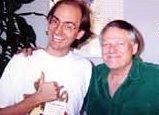 My only regret is that I didn’t think to ask him for a drawing of Roger on the cover. I did get this really cheesy photo of myself with him afterwards, which is on my website. I thought about doing a typically boring pose, but this other guy in front of me did that same wacky pose which I thought was funny.
My only regret is that I didn’t think to ask him for a drawing of Roger on the cover. I did get this really cheesy photo of myself with him afterwards, which is on my website. I thought about doing a typically boring pose, but this other guy in front of me did that same wacky pose which I thought was funny.
Oh! One thing I will mention about that is how the hotel I was staying in almost caught on fire while I was there. I don’t know if I was still suffering from jet lag or just that fact that I don’t get out much. I don’t drink or any of that other stuff. Well, I had decided to go to bed especially early that night and had already gotten into my pajamas. The fire alarm goes off. ‘Oh great, a stupid fire drill,’ I thought. ‘What lousy timing!’ I dressed as quick as I could, and started out. Just in case I was going to be standing outside like an idiot for half an hour, I grabbed my notes, which I kept in my book bag.
I step outside and look down the hallway. ‘Is that smoke?’ I thought. Hmm… Sure looked like smoke. And where’s the exit door? I got a little nervous. They had closed the doors, and the hallway looked unfamiliar now, so I had to go back and forth before locating the exit. I go downstairs and outside, and sure enough, smoke is pouring out of the restaurant next door to the hotel. Evidently, part of San Francisco city ordinance was to evacuate all adjoining buildings when one catches on fire. Smart law. There had been a kitchen fire, but the firemen had it under control pretty much by the time I got outside.
AV: How did you become a teacher yourself?
MS: As best as I can recall, I had been sort of hoping they’d ask me to teach the Animation class at Auburn University Montgomery, a couple of years after I’d graduated – I graduated in ’92 – and still no luck. I wasn’t terribly hopeful; I had no real experience teaching other than tutoring a kid in math back in high school.
 Anyway, I was almost or had just reached 25, and still living with my parents. Phil Coley, then head of the Graphic Design program at AUM called and asked me to have lunch with him. We met in the cafeteria, and he informed me that he needed my help in two things. First of all, he wanted me to teach the Animation class, as I’d hoped.
Anyway, I was almost or had just reached 25, and still living with my parents. Phil Coley, then head of the Graphic Design program at AUM called and asked me to have lunch with him. We met in the cafeteria, and he informed me that he needed my help in two things. First of all, he wanted me to teach the Animation class, as I’d hoped.
Secondly, he asked whether I’d be interested in serving as Director on a ‘short animated film.’ It was called Gladys, the Octopus Nurse. As best I could figure, a private nurse – possibly even then retired – had saved up some money and wanted to adapt this children’s book she’d written into an animated film. It ended up being about 13 minutes long, which was easily the longest animated project I’d worked on. We used student interns to do inking, scanning and painting, and I did most of the animation – if you could call it that. Well, I don’t mean to sound harsh on it; probably twenty years from now, I’ll look back at [the animation] I’m doing now and say the same thing.
I do think we genuinely did the best we could on an incredibly limited (four-figure) budget. The original plan was to complete it in maybe six months, and it ended up at nine. That sounds like a lot. You’ve gotta realize, none of us were working full-time on the video – even me. But we had a premiere, that turned out pretty well, I guess, for Montgomery. At least two of the TV stations showed up, and I got a nice write-up in the paper.
But the project gave me some experience working on a limited budget and managing student artists. That all came in handy, and I really owe Phil Coley a world of thanks for giving me a chance to work on the project.
AV: Any favorite memories that you’ve collected as a teacher?
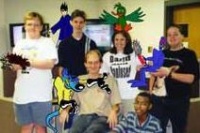 MS: Whenever a student tells me that they’ve learned something from one of my classes, that means a lot to me. That they’re willing to sit through all my endless anecdotes, hoping there’s some useful information tucked away somewhere, and they manage to find it.
MS: Whenever a student tells me that they’ve learned something from one of my classes, that means a lot to me. That they’re willing to sit through all my endless anecdotes, hoping there’s some useful information tucked away somewhere, and they manage to find it.
Seriously, I remember one student repeated something to me, about a tip I’d given him on inking a character. I think I said, ‘If you use a brush to ink your character, if you move the brush faster, the lines will come out smoother. Don’t give the ink time to bleed into your Bristol board.’ Chris, this guy who was into comics (and probably one of the most talented artists I’ve ever taught), repeated this advice I’d given him years later. ‘I told you that?’ I asked, and he confirmed that I had. I’m just glad it was useful.
AV: What lesson do animation students need to learn most today?
MS: First of all, the same thing Dick tells his students. I wish I had something more original to pass along, but he says the same thing an animation master told him, slowly and emphatically: ‘Learn… to… draw!’
If you genuinely want to get better at it, you’ll spend a minimum of an hour, but preferably two – daily. It’s like playing the piano – you have to practice to get better. If you really want to draw better, you’ll set aside excuses and distractions, and you’ll draw. If you have to go to a library to get away, turn off the blasted cell phone… and CD or mp3 player, then do it. But draw. If you’re serious about it, you’ll have more trouble stopping once you start.
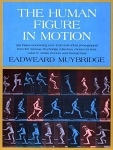 Also, beginning animators try to cram too much action in too short a space of time. I know I did. Learn the importance of pacing. Watch those old vaudevillians like Charlie Chaplin, Laurel and Hardy, and Buster Keaton. Learn timing from those guys; that’s who the Looney Tunes guys and the Disney folks learned it from.
Also, beginning animators try to cram too much action in too short a space of time. I know I did. Learn the importance of pacing. Watch those old vaudevillians like Charlie Chaplin, Laurel and Hardy, and Buster Keaton. Learn timing from those guys; that’s who the Looney Tunes guys and the Disney folks learned it from.
Study live-action and learn to draw the figure, from life if possible. If you can’t draw from life, get a reference book like Eadward Muybridge’s Human Figure in Motion or a more modern book, People and Poses, from the Comic Artist’s Photo Reference series.
I guess to that, I’d add, ‘Avoid my first mistakes. Don’t put everything you’ve ever done on a demo tape or DVD. Just your best work, no more than a minute or two. Producers are busy people, and if you can keep their attention for a minute, you’re doing great.’ My first demo reel was twelve minutes long. Bad mistake.
AV: How did you start Odd Job Puppets?
 MS: Well, originally Odd Job Puppets was supposed to be the live-action counterpart to MarkToons, so to speak. A slightly cheaper alternative for those who wanted cartoony humor in a TV commercial for a lower budget than animation would allow. The main thing I did was a handful of Halloween Station IDs for WNCF-TV, the ABC affiliate that I worked for in Montgomery from 2000 to about 2005. I did one or two Thanksgiving IDs, a Christmas ID, and finally a Valentine’s Day with Cowpid, a cow puppet. Besides that, I think my Halloween monster appeared in one TV spot there as a computer virus. And we did do one Halloween puppet show – well, they call them Fall Festivals nowadays – for this church I used to visit in Montgomery.
MS: Well, originally Odd Job Puppets was supposed to be the live-action counterpart to MarkToons, so to speak. A slightly cheaper alternative for those who wanted cartoony humor in a TV commercial for a lower budget than animation would allow. The main thing I did was a handful of Halloween Station IDs for WNCF-TV, the ABC affiliate that I worked for in Montgomery from 2000 to about 2005. I did one or two Thanksgiving IDs, a Christmas ID, and finally a Valentine’s Day with Cowpid, a cow puppet. Besides that, I think my Halloween monster appeared in one TV spot there as a computer virus. And we did do one Halloween puppet show – well, they call them Fall Festivals nowadays – for this church I used to visit in Montgomery.
Naturally, I’m such a pack rat, I still have all those puppets, so if someone out there wants a puppet TV commercial, just ask. Puppetry is almost like performing animation in real time. It’s a fun change of pace to performing in slow motion, so to speak, with animation.
AV: What is the history of your comic Bigfoot Country?
 MS: Bigfoot Country started out as an idea for a comic strip. Again, the idea of sitting at home drawing cartoons for a living appealed to me, rather than sitting in traffic an hour or two daily.
MS: Bigfoot Country started out as an idea for a comic strip. Again, the idea of sitting at home drawing cartoons for a living appealed to me, rather than sitting in traffic an hour or two daily.
The main thing I remember thinking was trying to design characters that would work well in black and white, and small. That’s what I hate about newspaper comics these days. Newspapers are suffocating the comics. Publishers don’t seem to realize the comics are the one exclusive thing that the internet still doesn’t provide as well as the newspaper – tangible, line art humor you can hold in your hand.
I tried sending it to a couple of syndicates and just couldn’t get a buyer soon enough to suit me. Probably I didn’t try hard enough, but that’s how I work… Something’s gotta pay the bills pretty soon, or I have to move on to something that does.
It’s sad, really. Whenever I go through my old sketchbooks or notepads, I find these ideas that I’m still rather fond of. I’d still like for them to see the light of day.
Anyway, I got kind of tired of telling these little three and four panel jokes that had to be reproduced the size of a short bookmark. I wanted to tell longer stories, and wanted more room to draw.
AV: How did your association with Comics from Concentrate begin?
 MS: It was my brother’s idea. He wanted to self-publish a comic book, just to see if we could get enough advertisers to pay for the printing, which we did. I think it basically broke even. He just came to me and asked, if he drew half a comic book, could I draw the other half? I was working with Bigfoot Country and had this idea about Deadbeat, a creative weirdo with a short attention span – yeah, nobody I could relate to… (ahem!). He’s a skunk who finds a typewriter in his garbage can, and decides to write a screenplay, when he finds out how much screenwriters make. So he writes this awful script for a horror movie which has every possible late night cliché wrapped into one film – it’s probably most heavily influenced by Ed Wood’s Plan 9 From Outer Space, which admittedly I’ve never seen, though I have seen the Tim Burton film about Mr. Wood.
MS: It was my brother’s idea. He wanted to self-publish a comic book, just to see if we could get enough advertisers to pay for the printing, which we did. I think it basically broke even. He just came to me and asked, if he drew half a comic book, could I draw the other half? I was working with Bigfoot Country and had this idea about Deadbeat, a creative weirdo with a short attention span – yeah, nobody I could relate to… (ahem!). He’s a skunk who finds a typewriter in his garbage can, and decides to write a screenplay, when he finds out how much screenwriters make. So he writes this awful script for a horror movie which has every possible late night cliché wrapped into one film – it’s probably most heavily influenced by Ed Wood’s Plan 9 From Outer Space, which admittedly I’ve never seen, though I have seen the Tim Burton film about Mr. Wood.
The plot is that his friends make all these suggestions that might actually improve his chances of selling the screenplay, but he’s so impatient he drops it in the mail when they’re not looking. Surprisingly, a low-budget movie studio buys the screenplay and agrees to shoot it in their forest. It’s the overnight success story everybody wants but nobody wants to admit wanting.
I’d still like to make that as a half-hour, animated Halloween special.
AV: What is the story behind your first book, The Lost World Adventures?
MS: I’m really interested in the subjects of creationism and cryptozoology, the study of mystery animals – particularly modern dinosaur survivors – and that’s what it’s all about. I took the characters from Sir Arthur Conan Doyle’s classic, The Lost World, and turned it into a story about a creationist and an evolutionist who find a plateau in the Amazon inhabited by dinosaurs. Not long after that, I think A&E had their special, based on the original book, with Bob Hoskins as Professor Challenger. Obviously, their dinosaurs were great, but they took on the ‘creation vs. evolution’ issue from the opposite side that I took it. They treated the creationists as loonies, and well, I… um… happen to see it the other way around.
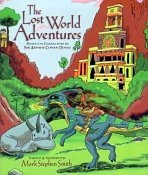 Don’t get me wrong; I don’t think A&E, or whoever produced the film, ever saw my book. It was a fairly low print run, I think. It was probably already in production by the time my book hit the shelves, for all I know.
Don’t get me wrong; I don’t think A&E, or whoever produced the film, ever saw my book. It was a fairly low print run, I think. It was probably already in production by the time my book hit the shelves, for all I know.
If you look at those fossilized dinosaur tracks in Glen Rose, Texas, with human footprints inside the dinosaur tracks, I’d say it’s a pretty darn good argument that the world simply isn’t as old as the evolutionists would have us think. They’re just kinda stuck on their whole ‘dinosaurs have been dead 65 million years old and we won’t listen to any arguments that say otherwise. Don’t dare question our authority! End of story.’
There is some fascinating evidence otherwise, if you open your mind and do a bit of reading. There’s a great book called Secrets of the Ica Stones and Nazca Lines. Check out these stones that have carvings of men not only fighting dinosaurs but riding dinosaurs, recognizable species (not just generic ‘dragons’), and in one case riding a flying pterosaur. Evolutionists naturally tried to say they were hoaxes. Let’s face it, it’s easier and less expensive for them to cry ‘hoax!’ than rewrite all their textbooks. They tried to claim that one peasant guy had created all these thousands of intricate carvings of men and dinosaurs on stone – with a hacksaw. They ignored the fact that the grooves were covered by layers of material that takes centuries to build up. They ignored the fact that even the Spanish Conquistadores wrote of these same stones centuries ago.
Anyway, I wanted to make this story into an animated feature. But the guy I approached, Ken Ham of Answers in Genesis, said they didn’t have the budget to make it into an animated feature. He liked my suggestion of making it an interactive CD-ROM comic book, and when I talked it over with his manager later, we hit on the idea of doing it as an illustrated children’s book. And of course that’s how we did it.
I’d still love to make it into an animated feature, if there’s anyone out there listening.
AV: Why did you decide to write The Art of Flash Animation: Creative Cartooning?
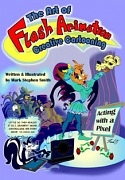 MS: My wife had already gotten her job in Atlanta, I think, at an architectural firm. I had already started as Creative Services Director at ABC-32, directing plain old live-action commercials. I had a pretty decent job there, but I figured that was as far as I could ever go in Montgomery. Freelance by then had pretty much dried up. Quick Pawn Shops had a new Marketing Director and didn’t care much for animation, evidently. I’d get the occasional animated spot here and there, but I couldn’t count on it to follow any kind of pattern – nothing I could count on paying the rent with.
MS: My wife had already gotten her job in Atlanta, I think, at an architectural firm. I had already started as Creative Services Director at ABC-32, directing plain old live-action commercials. I had a pretty decent job there, but I figured that was as far as I could ever go in Montgomery. Freelance by then had pretty much dried up. Quick Pawn Shops had a new Marketing Director and didn’t care much for animation, evidently. I’d get the occasional animated spot here and there, but I couldn’t count on it to follow any kind of pattern – nothing I could count on paying the rent with.
The main thing, though, was that my wife had gotten a job out of town, and since I liked being married to her, I knew I needed to start looking in Atlanta, too. I saw something on Animation World Network’s job site of a 3D studio in Atlanta, where they were looking for storyboard artists. I figured that even though I couldn’t do 3D, I could draw storyboards for it. So I sent them some samples or a link to my portfolio, whatever I did, and they soon replied. Even though I ‘wasn’t what they were looking for,’ one guy at the studio knew this guy in Texas – Wes, I think they directed me to – who was looking for someone to write a book on Flash Animation.
AV: What were the steps you took in writing it?
MS: Well, the first thing I had to do was to learn Flash. I had grown so attached to MacroMedia Director and had to get off my butt and learn Flash. I tried going through the tutorials in the manuals which were available, which I didn’t much care for. They were too dry, boring, and most of the books I could find were bogged down with ActionScript info.
 So, essentially I set out to write the manual I wish I’d had to start with. And one of my students told me he read the first three chapters pretty much without putting it down. And this was a good student; he had no reason to attempt flattery, so I took him for his word.
So, essentially I set out to write the manual I wish I’d had to start with. And one of my students told me he read the first three chapters pretty much without putting it down. And this was a good student; he had no reason to attempt flattery, so I took him for his word.
I think the first thing they asked me to do was write an outline. So I divided the first half of the book into ‘How to Draw Animation,’ and the second half into ‘Animating with Flash.’ I just broke it down piece by piece after that.
I’d send them a couple of chapters at a time, and then they’d send me a check, and stage by stage, that’s how it happened. I had a terrific editor, Beth Kohler, who proofread for me and checked behind me to make sure the steps included in the book worked – y’know, that I hadn’t left anything out.
And of course I have to thank the publisher, Tim McEvoy, for being so patient with my snail’s pace of writing – or what I felt like it must have seemed to him – because of course, by this point, I was now teaching at Westwood.
AV: How long did it take you to complete the book?
MS: From start to finish, roughly a year.
AV: What were some of the challenges you faced in writing it?
 MS: The biggest challenge was time. As I said, I was teaching during the day, and after a day of teaching, you don’t necessarily feel like typing for a couple of hours before supper, a couple of hours after maybe… But these people have been nice enough to invest their checks and confidence in you, so you just… kind of do it, even if you don’t necessarily feel like it.
MS: The biggest challenge was time. As I said, I was teaching during the day, and after a day of teaching, you don’t necessarily feel like typing for a couple of hours before supper, a couple of hours after maybe… But these people have been nice enough to invest their checks and confidence in you, so you just… kind of do it, even if you don’t necessarily feel like it.
At times I thought, ‘Why didn’t they just get an animator at Cartoon Network to write this? Those guys are the real experts at Flash Animation!’ But of course, their schedules are even tighter than mine.
AV: Was it difficult finding a publisher for Creative Cartooning?
MS: No, as I said, they pretty much wanted me to write the book for them upon our first conversation. It’s kind of odd, the two books I’ve actually had published were sort of ‘pre-sold,’ from that standpoint.
On the other hand, as a teenager through my early twenties, I’ve written six novels and maybe thirty short stories. All of those were unpublished, of course, but good practice.
And now, of course, ironically I’d like to see them as animated features. Maybe a couple in live-action, with animatronic monsters from the Jim Henson Creature Shop. That would be nice.
AV: Who are some of your influences in animation?
MS: I’d have to say Richard Williams, first and foremost. His characters have the most fluid motion I’ve ever seen, from Roger Rabbit to Thief and the Cobbler, and even the Harlem Globetrotters TV ad he did. He did some terrific TV commercials, which I still marvel at.
 Otherwise, Ralph Bakshi has been a big influence. I know he’s fond of his gritty urban dramas like Heavy Traffic and so on, but I didn’t care much for those. I preferred his fantasy films like the animated version of Lord of the Rings, Fire and Ice, and particularly Wizards. It was a strange juxtaposition of styles, most of all in Wizards. You’d have these Saturday morning cartoon style characters in wonderfully elaborate backgrounds, and then these hideous goons, and mix that in with rotoscoped World War II footage. And what a great message, the film had. Don’t rely so much on technology: it’ll turn on you and de-humanize society.
Otherwise, Ralph Bakshi has been a big influence. I know he’s fond of his gritty urban dramas like Heavy Traffic and so on, but I didn’t care much for those. I preferred his fantasy films like the animated version of Lord of the Rings, Fire and Ice, and particularly Wizards. It was a strange juxtaposition of styles, most of all in Wizards. You’d have these Saturday morning cartoon style characters in wonderfully elaborate backgrounds, and then these hideous goons, and mix that in with rotoscoped World War II footage. And what a great message, the film had. Don’t rely so much on technology: it’ll turn on you and de-humanize society.
Bakshi ‘indirectly’ sent me an email, through the webmaster of his online store. I had the audacity to ask about a two-disc edition of Cool World – hey, I actually liked the movie, okay! I’d learned from Barry Jackson, the background artist, a whole sequence was deleted from the film.
Anyway, Bakshi laughed, I was told, at the idea of a two-disc Cool World. Anyway, he directed the store to send me a free Peace T-shirt, because he had a soft spot for teachers. And he said to make sure I’m telling those kids about doing ‘real animation’ – animation from the heart, that actually means something, instead of what he calls ‘slick stuff.’
 I guess what impresses me about Bakshi is his working method. Just the fact that he’s an ‘independent animator’ who manages to get these personal films made, instead of your typical Hollywood ‘kiddie’ features or ‘anime’ shelf-liners.
I guess what impresses me about Bakshi is his working method. Just the fact that he’s an ‘independent animator’ who manages to get these personal films made, instead of your typical Hollywood ‘kiddie’ features or ‘anime’ shelf-liners.
I also really enjoy the work of E.C. Segar, the cartoonist who created Popeye, and the Max Fleischer cartoons of Popeye, Superman, and Betty Boop. I almost don’t have to mention Disney, but I always enjoyed their Halloween specials.
As far as comics, I don’t read them much anymore – except on Free Comic Book Day. And I’ll usually get some back issues at comic book conventions, like those old Gold Key and Charlton Comics with Hanna Barbera characters, Archie’s Jughead, and Disney Comics Digests sometimes, especially Carl Barks or Don Rosa’s Uncle Scrooge. I did like Spooky, the Tough Lil’ Ghost for some reason. My three favorite modern cartoonists would have to be Jeff Smith, who did the groundbreaking work in Bone, and the two prematurely-retired newspaper cartoonists, Calvin and Hobbes‘ Bill Watterson and The Far Side‘s Gary Larson.
AV: Animator, author, illustrator, teacher, cartoonist, puppeteer – under which of these titles do you enjoy working most?
MS: Cartoonist, I guess, is how I have a tendency to silently describe myself, although I’ve enjoyed teaching. The rewards of teaching have surpassed the dollar signs in ways I can’t say I really expected. It’s nice to see the students’ enthusiasm for drawing or animation or special effects light up their faces, and to think I’ve influenced that is a strangely humbling experience.
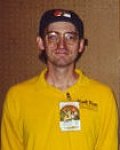 I don’t really call myself an animator. Dick said that animator is a gift word like ‘poet.’ A poet shouldn’t really refer to himself as a poet until another does so first, and I just don’t think my characters move with the fluid artistry yet that warranties the title ‘animator.’
I don’t really call myself an animator. Dick said that animator is a gift word like ‘poet.’ A poet shouldn’t really refer to himself as a poet until another does so first, and I just don’t think my characters move with the fluid artistry yet that warranties the title ‘animator.’
But the most rewarding time of my day is when I can just shut out the world, even if it’s just for half an hour, and draw. That’s the only drawback of teaching or even directing others. The other artists constantly want your approval, when I’d rather be drawing. But that’s a comparatively minor complaint. It does make me feel good that they value my opinion of their work and desire my guidance.
Puppetry has pretty much become a hobby again, and there are a few puppets I’ve bought material for but haven’t managed to make the time to start them. I’m hoping to get them done by Halloween. One I’d like to do is the Count von Count from Sesame Street; I did actually begin his head over my last between-term break, during a trip to visit my Dad in Florida. The other is a Gremlin, from Gremlins 2. I’d really like to build that.
AV: In your career, what would you say has been your biggest accomplishment?
MS: Boy, that’s a tough one. I guess anything I’ve done, any personal film or project I’ve managed to make the time to actually finish while working any mostly full-time job.
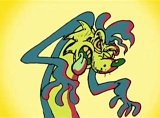 I feel the most satisfied by Zombie Skunk Ghouls, the preview I did for the Bigfoot Country characters, which is on my website, MarkToonery.com, on the ‘Features’ page. I pretty much wrapped up the feeling for the story in that short two-minute preview.
I feel the most satisfied by Zombie Skunk Ghouls, the preview I did for the Bigfoot Country characters, which is on my website, MarkToonery.com, on the ‘Features’ page. I pretty much wrapped up the feeling for the story in that short two-minute preview.
I do have to say I feel a special sense of accomplishment with the few awards I’ve won for my animation. I won my first Telly, a bronze, for the animation on Bigfoot Country: Ridin’ Bearback. I won an Addy for the Thermalex Sales Video in 2000, and then I just found out that I won a Silver Medal Telly for a Pittsburgh TV spot I finished in March.
AV: Which of your projects would you call the most challenging?
MS: Probably anything that I have to do while also working a full-time job. I’d really like to comfortably afford animating and/or cartooning full-time by itself. But I’d probably still teach at least one class on the side, just to stay on top of things.
AV: From your cast of characters, which one is your favorite?
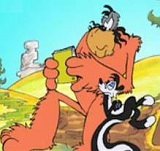 MS: Again, another tough one. It’s like asking a parent to name a favorite child. Still, that being said… It’s a close tie between Sezquatch, who I see as the upstanding moral character I’d like to be, I try to be… and Deadbeat Skunk, the creative weirdo with a short attention span who wants to be an overnight success. Admittedly, it’s a combination of those two halves that seems to be the whole person.
MS: Again, another tough one. It’s like asking a parent to name a favorite child. Still, that being said… It’s a close tie between Sezquatch, who I see as the upstanding moral character I’d like to be, I try to be… and Deadbeat Skunk, the creative weirdo with a short attention span who wants to be an overnight success. Admittedly, it’s a combination of those two halves that seems to be the whole person.
A close third would be Jayle Bat, mainly because she’s one of the first marginally original characters I feel I’ve designed that makes for an attractive female. My brother once reluctantly informed me that I needed to work on making my female drawings more attractive. About a year or so later, I came up with Jayle, and Chris, one of my animation students, practically begged me for a drawing of her. It made me feel like my practice had finally paid off.
AV: What projects are you currently developing or hoping to develop?
MS: Well, that’s a tough question to answer, partially because a couple of them are ones I haven’t had copyrighted officially yet, and those are the ones I’m giving the most attention right now. I’ll just say it’s a parody of a somewhat recent disaster in the animation industry, and leave it at that. I will say I’m planning it as a series of installments, like Kerry Conran originally planned to do with Sky Captain before it got picked up by Paramount, only I’ll post it on my website and pitch it to a network or two.
One I don’t mind mentioning (that I have copyrighted) is The 13th Hour, sort of a throwback to my younger days. We actually did a play of three of my short stories I’d written as a teenager, in the Twilght Zone and Alfred Hitchcock Presents vein. That was 1988, my senior year in high school. Now that we’re coming up on my 20th year reunion, I’d really like to do them as an animated series.
Of course, I’d like to see The Lost World Adventures as an animated feature, either theatrical or even direct-to-DVD. But mostly, I’d like that Bigfoot Country Halloween Special to get made, if I had only one choice of all my projects.
AV: Over the course of your career, what are some of the most valuable lessons you’ve learned?
 MS: Like Eddie Cantor said, it takes twenty years to become an overnight success. Success doesn’t ‘just happen.’ It takes work. Constantly work on your portfolio or demo reel. If you can’t get paid for animation jobs, don’t work for free – except for yourself.
MS: Like Eddie Cantor said, it takes twenty years to become an overnight success. Success doesn’t ‘just happen.’ It takes work. Constantly work on your portfolio or demo reel. If you can’t get paid for animation jobs, don’t work for free – except for yourself.
Don’t get me wrong; I’m not saying don’t do volunteer work for charitable organizations. I’m just saying that there are too many people out there willing to take advantage of your talents for free if you allow them – if you empower them to do so. (I’ve run into more than my share…) Be on your guard and proceed with caution.
Network – fancy word for ‘meet’ – with people in the industry and get to know them if possible. Sometimes you’ll be surprised how willing successful people can be to share information. But sometimes what worked for one person doesn’t work for another. There are no career guarantees.
And thank God for your blessings, great and small. I’ve had more than my share of those also, and have been extremely grateful for each of them… and those to come.
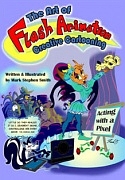
from Amazon or direct from the publisher’s website at WordWare.com
From the entire Animated News & Views team, special thanks to Mark Smith for kindly participating in this interview.



